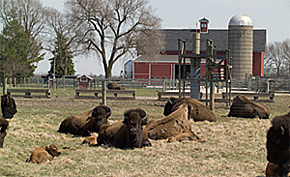Frolicking bison
 |
As spring arrived, so did the kids. Their knees wobbly and eyes wide open, they stayed close to their moms. Dad, weighing more than 2500 pounds, made sure that no harm came the babies' way.
Fermilab's herd of bison welcomed its first new family member before crocuses broke the ground and daffodils opened their flowers. By the end of April, about 25 calves were born. Within a couple of days of birth, the little beasts were brave enough to run around, while the adults slowly wandered across the pasture. Looking at the massive grownups, who would have guessed that the little ones could be so bouncy?
Fermilab has been home to bison for more than 30 years. Founding director Robert Wilson introduced the first seven animals from Wyoming and Colorado, bringing a symbol of 19th-century Illinois back to the grounds. Today, the buffalo, as they are commonly called, are as much a part of Fermilab as Wilson Hall and the tall-grass prairie.
Every year, thousands of visitors come to see the animals. But the fling with youth only lasts through the summer. By fall, the calves' hair will have turned dark brown, marking the transition into adulthood, and their frolicking will have stopped. For many of them it will also be the time to say goodbye: farmers from across the Midwest will be bidding for the animals at a silent auction.
In 1889, only 600 bison remained in North America. Today, more than 200,000 roam the continent.
Kurt Riesselmann
 Photos: Reidar Hahn, Fermilab |
Click here to download the pdf version of this article.






